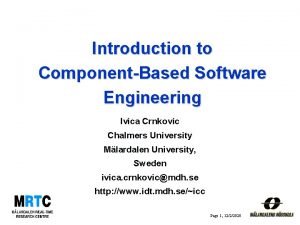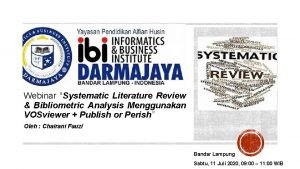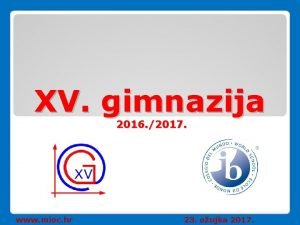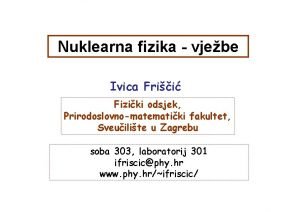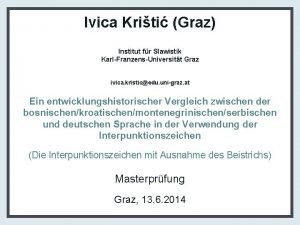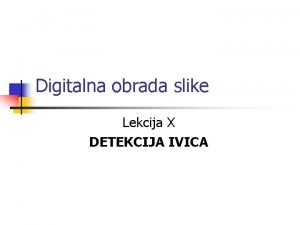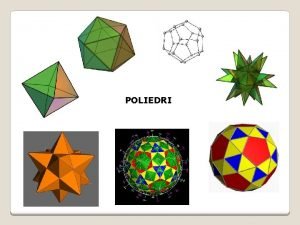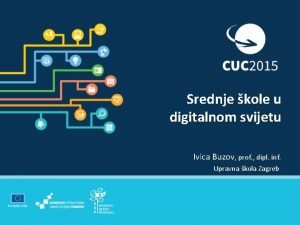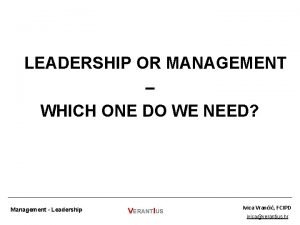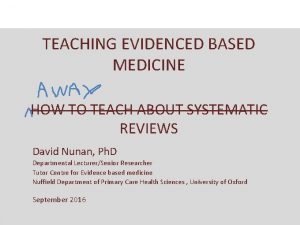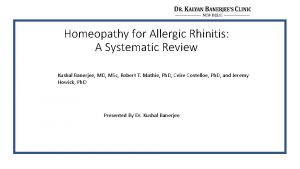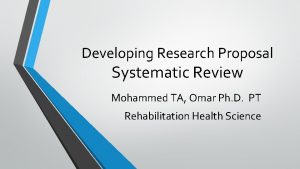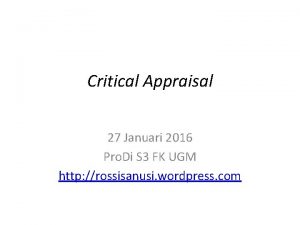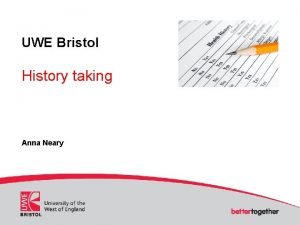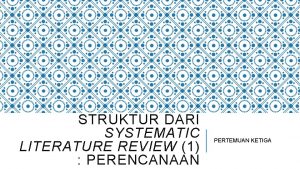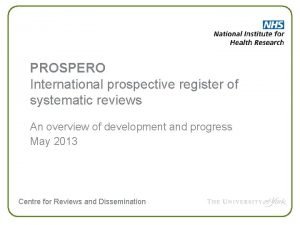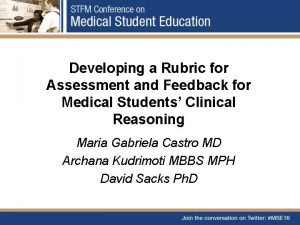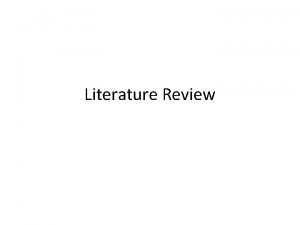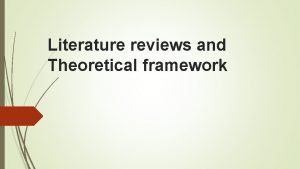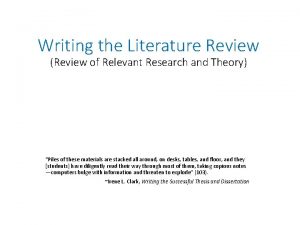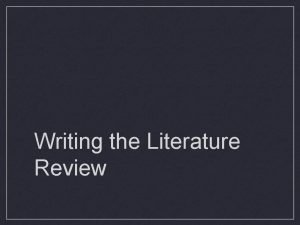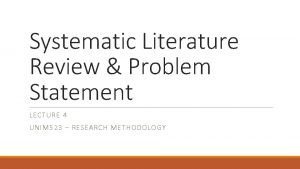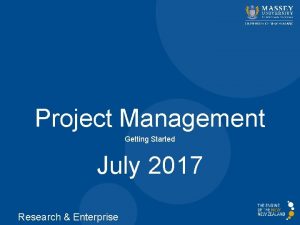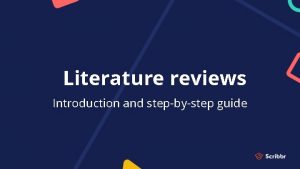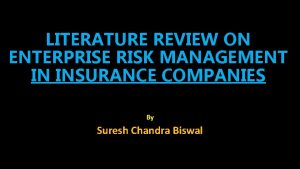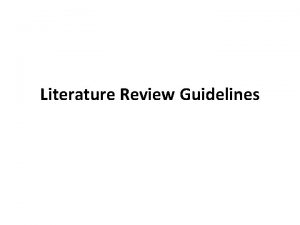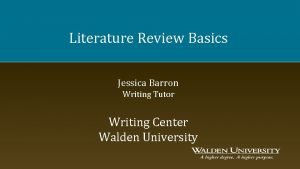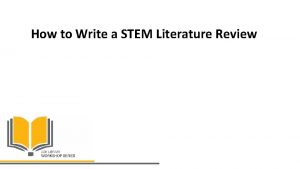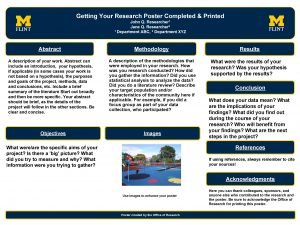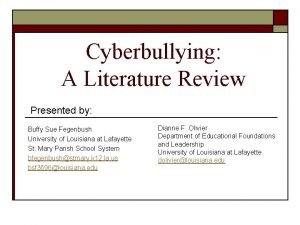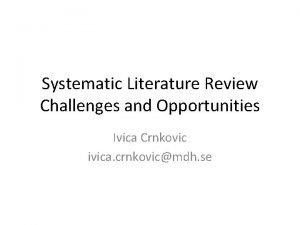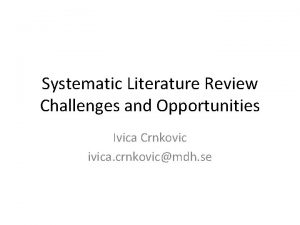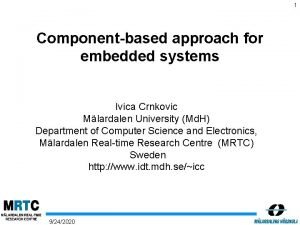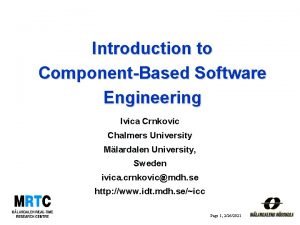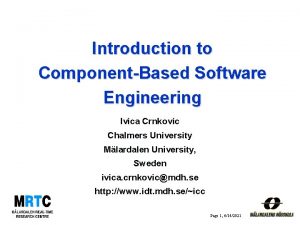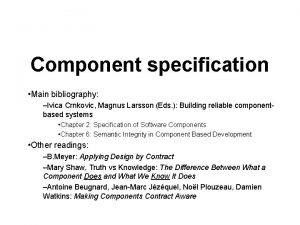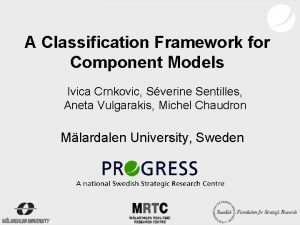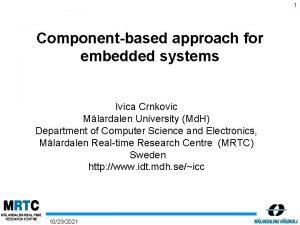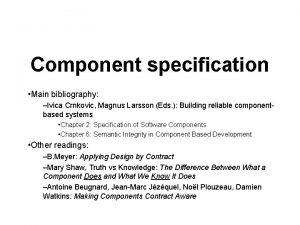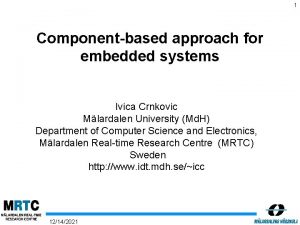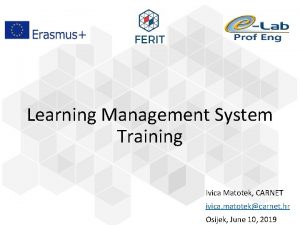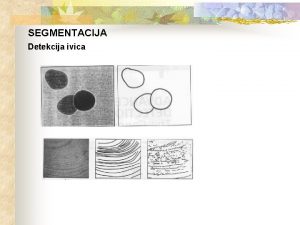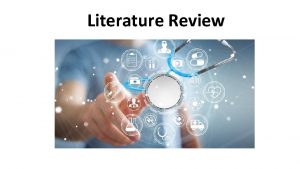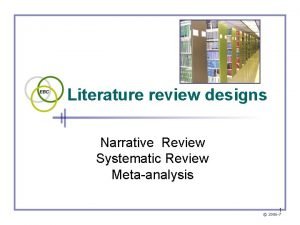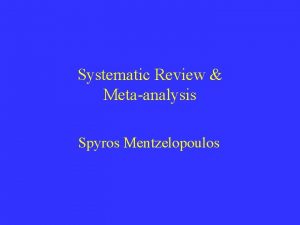Systematic Literature Review Challenges and Opportunities Ivica Crnkovic















































- Slides: 47

Systematic Literature Review Challenges and Opportunities Ivica Crnkovic ivica. crnkovic@mdh. se

Empirical SE Questions? • The questions similar to those an anthropologist might ask during first contact with a previously unknown culture. – How do people learn to program? – Can the future success of a programmer be predicted by personality tests? – Does the choice of programming language affect productivity? – Can the quality of code be measured? – Can data mining predict the location of software bugs? – ……. Greg Wilson, Jorge Aranda, Empirical Software Engineering, American Scientist https: //www. americanscientist. org/issues/pub/empirical-software-engineering

Empirical Software Engineering • Evidence of particular aspect of SE – Activities, processes, technologies – Best practices, Lessons learned – Increased knowledge – Showing a new perspective of a particular knowledge. – …. –

Empirical Software Engineering Methods Case studies Surveys Literature reviews

Systematic Literature Review (SLR) • Finding evidence from (scientific) literature – Do it in a systematic way • State a question • Find the answer Based on Barbara Kitchenham, Evidence-Based Software Engineering and Systematic Reviews www. scm. keele. ac. uk/ease 05_bk. ppt

Systematic (Literature) Review • Questions – – what are the current problems in a specific area? for a specific problem what are the reported solutions? Which are the newest results in a particular area? Which particular combination of two/several areas do exist? • Important! – The questions should be interesting form a research point of view – The questions should be attractive for the readers – The questions should be enough general to come to a conclusions that are sufficiently general – The questions should be specific enough to be able to provide enough specific findings

Systematic Review Procedure • Support Evidence-based paradigm – Start from a well-defined question • Step 1 – Define a repeatable strategy for searching the literature • Step 2 – Critically assess relevant literature • Step 3 – Synthesise literature • Step 4 Ref: Barbara Kitchenham, Evidence-Based Software Engineering and Systematic Reviews 7

Systematic Review Process Develop Review Protocol Plan Review Validate Review Protocol Identify Relevant Research Select Primary Studies Conduct Review Assess Study Quality Extract Required Data Synthesise Data Document Review Write Review Report Validate Report 8

Showing the SLR through an example Example #1 Example 1: A systematic review of software architecture evolution research. Hongyu Pei Breivold, Ivica Crnkovic, Magnus Larsson, Information & Software Technology 54(1): 16 -40 (2012) • software evolvability – the ability of a system to accommodate changes in its requirements throughout the system’s lifespan with the least possible cost while maintaining architectural integrity” • Interest: evolvability through software architecture

Evolvability property model Evolvability is refined to 1 1. . * subcharacteristics 1 1. . * is refined to measuring attributes measured by 1 1. . * metrics 1 reason about Question: which are subcharacteristics? 6/15/2021 1. . * Qo. S Evolvability subcharacteristics Analyzability Architectural Integrity Changeability Portability Extensibility Testability Domain-specific attributes 10

Showing the SLR through an example Example #2 Example 2: 15 Years of CBSE Symposium: Impact on the Research Community Josip Maras, Luka Lednicki, Ivica Crnkovic ACM/Sig. Soft Component-based Software Engineering Symposium 2012 • Interest: What is the impact of CBSE Symposium publications?

CBSE events Qo. SA Comp. Arch WCOP ISARCS (WICSA) 2021 -06 -15 1998 – Tokyo 1999 – Los Angeles 2000 – Limerick 2001 – Toronto 2002 – Orlando 2003 – Portland 2004 – Edinburgh 2005 – St. Louis 2006 – Västerås 2007 – Boston 2008 – Karlsruhe 2009 – E. Stroudsburg 2010 – Prague 2011 – Boulder 2012 - Bertinoro CBSE 2012 - Bertinoro, Italy Workshop@ICSE Initiation Focus Symposium@ICSE Broadening Scope Symposium!@ICSE Collaboration phase 12

Systematic Review Process Develop Review Protocol Plan Review Validate Review Protocol Identify Relevant Research Select Primary Studies Conduct Review Assess Study Quality Extract Required Data Synthesise Data Document Review Write Review Report Validate Report 13

Developing the Protocol • Review protocol – Specifies methods to be used for a systematic review – Predefined protocol • Reduces researcher bias by reducing opportunity for – Selection of papers driven by researcher expectations – Changing the research question to fit the results of the searches – Good practice for any empirical study 14

Protocol Contents -1/3 • Background – Rationale for survey • Research question – Critical to define this before starting the research – Strategy used to search for primary sources 15

Protocol Contents – 2/3 • Strategy to find primary studies – – Search terms/keywords Identify resources, databases, journals, conferences Procedures for storing references How publication bias will be handled • Grey literature • Direct approach to active researchers – How completeness will be determined • Useful to have the baseline paper to set start date • Selection Strategy – Inclusion/exclusion criteria • Handling multiple papers on one experiment • Quality assessment criteria 16

Protocol Contents- 3/3 • Data extraction – What data will be extracted from each primary source – How to handle missing information – How data extraction reliability will be addressed • Usually multiple reviewers – Where data will be stored • Procedures for data synthesis – Formats for summarising data – Measures and analysis if meta-analysis is proposed 17

Research questions Search Keywords Resources/Database Search Studies SLR process Inclusion/Exclusion criteria filtering Primary Studies legend analysis Statistical data synthesis New findings activity artifact

Example 1 (Software Architecture Evolution) Research questions 1. What approaches have been reported regarding the analysis and achievement of software evolvability at the architectural level? 2. What are the main research topics covered in the scientific literature regarding analysis and achievement of evolvability-related quality attributes? 3. …. . 4. What is the impact of the studies to research community and practice?

Example 1 (Software Architecture Evolution) Research questions Search Keywords Search keywords S 1: software architecture AND evolvability S 2: software architecture AND maintainability S 3: software architecture AND extensibility S 4: software architecture AND adaptability S 5: software architecture AND flexibility S 6: software architecture AND changeability S 7: software architecture AND modifiability S 8: software architecture AND analyzability Resources/Databases & Resources: ACM Digital Library IEEE Xplore Science. Direct – Elsevier Springer. Link Wiley Inter. Science ISI Web of Science SCOPUS (Google Scholar ) Keywords should reflect the questions and the underlying theory/model

Example 2 (CBSE publications) Research questions Questions Impact - Number of publications, total, per year, geographical distribution - citation index - Indirect impact: backward citations, Impact of the authors - What is the maturity level of CBSE? Topics of interest Which research topics where the most present at CBSE? What kind of research results were presented? What type of validations the publications had?

Example 2 (CBSE publications) Research questions Questions Impact - Publications - citation index - Indirect impact Topics of interest Search Keywords Search keywords No search keywords - all CBSE papers Resources/Databases & Resources: CBSE Proceedings Springer. Link ACM Didgital Library Google Scholar Web search

Search Studies filtering Primary Studies Example 1: Primary studies selection process

Search Studies filtering Primary Studies Example 1: Primary studies selection process

Search Studies filtering Primary Studies Example 1: Primary studies selection process • Activities: – Provide search strings in databases and export the results to End. Note • Tedious work – different query languages and different export functionality – Extraction of the information in a suitable form for reading and selecting, removing duplicates, etc. • Goal: – To get a reasonable number of studies (<500, >20) • May require refinement of the questions – Achieve reliability – select the most significant literature

Search Studies filtering Primary Studies Example 2 (CBSE publications) • All publications are primary studies – 318 studies • Activities – Extract publications and create an relationaldatabase – Populate database – Provide “Query and View” interactive web-based application for fast reading and publication classification

analysis Statistical data • Data extracted from the studies – “objective data” – Distribution of studies with respect to • • Year of publications Authors and research communities Sources of publications Citation distribution, the most cited studies • Analysis support – Manual, writing own software, – Help from some tools/portals • Google scholar • Perish & publish • Mendeley, …

analysis Statistical data Example 1: statistical data

analysis Statistical data Example 1: statistical data

analysis Example 2: statistical data Statistical data 100 90 80 70 60 50 40 30 20 10 0 4000 3500 3000 2500 2000 1500 1000 500 0 # submitted # published 1 2 3 4 5 6 7 8 9 10 11 12 13 14 15 #citations - total: 3405 – (measured 2012 -02 -12) 1 2 3 4 5 6 7 8 9 10 11 12 13 14 1000 800 600 # citations per year 400 200 0 1 2 3 4 5 6 7 8 9 10 11 12 13 14

analysis Statistical data Example 2: statistical data Top 10 citations Citation of papers that cited top 10 papers The most influential Authors from CBSE (citations of the related work)

synthesis New findings Procedures for data synthesis • Goal: synthesize the information into a new knowledge – Based on a theory previously established • Validation of theory • Description of some specific characteristics of theory – Grounded theory • Build up a theory from the reading & analysis – Manual – Using some tools – the most frequent words, Concordance • The most difficult part – Requires experience and knowledge in the subject – Requires a kind of validation/review

synthesis New findings Example 1 (Software Architecture Evolution)

synthesis New findings Example 1 (Software Architecture Evolution) Maturity classification: • Basic research • Concept formulation • Development and extension • Internal use • External use • Popularization

synthesis New findings Example 2 (CBSE publications) Component models 15% 24% 12% Component technologies Research Area Extra‑functional properties Composition & predictability 7% 15% 13% 8% 6% Software Architecture Lifecycle Domains Methodology Result characteristics • Procedures or techniques • Qualitative models • Analytic models • Notations or tools • Specific solutions • Judgments • Reports • Empirical models

synthesis New findings Example 2 (CBSE publications) Evaluation Type • Not presented • Academic case study • Simple examples • Experiments • Industrial case study • Formal specification • Literature review Research Maturity • External enhancement and exploration • Internal enhancement and exploration • Development and extension • Conceptual formulation

Validation issues 0. Is your approach OK? – Do you have the right questions? – Is the procedure feasible? 1. How you can ensure that you have selected the right studies? 2. How you can ensure that your analysis and synthesis is right?

The right studies? 1. Are the selected sources appropriate – Selection of databases important (fortunately there are not so many) – Is Google/Google Scholar appropriate as a source? 2. Have you missed to select some important studies? Do you have too many unimportant studies?

Studies selection • Several researchers involved in the process Selected studies A Selected studies using automatic queries Selected studies B D comparison Discussion Selected studies C Filtering Final list

Comparison • Agreement? Fleiss’ kappa

Synthesis/Findings Validation a) Your analysis/synthesis is based on a theory/model a) b) c) Existing classification, ontology Previous research results Extending/refinement of the existing theories b) You build your theory/model from start Iterative process – building & validation Validation by a third person Synthesis Discussion

Reporting results • Several levels of information – Raw source information – Extensive detailed technical report – Research papers (Journal, Conference) – reference to source data, technical report

Write an SLR paper 1/2 • Intro – Motivation – the most important • Why the question is interesting • What is the main question • The overall method used • The questions, the search keywords, source of information • Election process, data storage • Selected studies • Refer to the most important studies • Provide statistics, comment them

Write an SLR paper 2/2 • Synthesis – Important – The findings (short description in general) – The findings related to the studies (classification/grouping of the studies) • Discussion – Additional findings, remarks, statistics from the studies related to the findings • Validation – Validation threat – Validation procedures (this can be specified in the methods part) • Conclusion • List of primary studies • references

Some Research Databases • • SCOPUS http: //www. scopus. com/home. url ACM Digital Library (http: //portal. acm. org) Compendex (http: //www. engineeringvillage. com) IEEE Xplore (http: //www. ieee. org/web/publications/xplore/) Science. Direct – Elsevier (http: //www. elsevier. com) Springer. Link (http: //www. springerlink. com) Wiley Inter. Science (http: //www 3. interscience. wiley. com) ISI Web of Science (http: //www. isiknowledge. com).

References for the systematic review Kitchenham, Barbara. Procedures for Performing Systematic Reviews, Joint Technical Rreport, Keele University TR/SE-0401 and NICTA 0400011 T. 1, July 2004. Australian National Health and Medical Research Council. How to review the evidence: systematic identification and review of the scientific literature, 2000. IBSN 1864960329. Australian National Health and Medical Research Council. How to use the evidence: assessment and application of scientific evidence. February 2000, ISBN 0 642 43295 2. Cochrane Collaboration. Cochrane Reviewers’ Handbook. Version 4. 2. 1. December 2003. Glass, R. L. , Vessey, I. , Ramesh, V. Research in software engineering: an analysis of the literature. IST 44, 2002, pp 491 -506 Magne Jørgensen and Kjetil Moløkken. How large are Software Cost Overruns? Critical Comments on the Standish Group’s CHAOS Reports, http: //www. simula. no/publication_one. php? publication_id=711, 2004. Magne Jørgensen. A Review of Studies on Expert Estimation of Software Development Effort. Journal Systems and Software, Vol 70, Issues 1 -2, 2004, pp 37 -60. 46

References for the systematic review Khan, Khalid, S. , ter Riet, Gerben. , Glanville, Julia. , Sowden, Amanda, J. and Kleijnen, Jo. (eds) Undertaking Systematic Review of Research on Effectiveness. CRD’s Guidance for those Carrying Out or Commissioning Reviews. CRD Report Number 4 (2 nd Edition), NHS Centre for Reviews and Dissemination, University of York, IBSN 1 900640 20 1, March 2001. Pai, Madhukar, Mc. Cullovch, Michael, Gorman, Jennifer D. , Pai, Nitika, Enanoria, Wayne, Kennedy, Gail, Tharyan, Prathap, Colford, John M. Jnr. Systematic reviews and meta-analysis: An illustrated, step-by-step guide. The National medical Journal of India, 17(2) 2004, pp 86 -95. Sackett, D. L. , Straus, S. E. , Richardson, W. S. , Rosenberg, W. , and Haynes, R. B. Evidence-Based Medicine: How to Practice and Teach EBM, Second Edition, Churchill Livingstone: Edinburgh, 2000. 47
 Chalmers software engineering
Chalmers software engineering Vosviewer alternative
Vosviewer alternative Mioc predmeti
Mioc predmeti Alen crnković
Alen crnković Nader amin-salehi
Nader amin-salehi What is inclusion and exclusion criteria
What is inclusion and exclusion criteria Narrative review vs systematic review
Narrative review vs systematic review Example of opportunity in media and information
Example of opportunity in media and information Greater bay area opportunities and challenges
Greater bay area opportunities and challenges Nuklearna fizika fakultet
Nuklearna fizika fakultet Ivica kristic
Ivica kristic Ivica osom
Ivica osom Koliko strana ima kvadar
Koliko strana ima kvadar Ivica diedra
Ivica diedra Biljana buzov
Biljana buzov Ivica toljan
Ivica toljan U registraturi kratki sadržaj
U registraturi kratki sadržaj Kako izracunati zapreminu kvadra
Kako izracunati zapreminu kvadra Ivica vrančić
Ivica vrančić Ivica vilibić
Ivica vilibić Ivica i janica kostelić životopis
Ivica i janica kostelić životopis Qfas systematic review
Qfas systematic review Dr. kushal banerjee
Dr. kushal banerjee Prospero review registration
Prospero review registration Systematic review research proposal
Systematic review research proposal Contoh critical appraisal jurnal systematic review
Contoh critical appraisal jurnal systematic review Anna neary
Anna neary Pengertian systematic review
Pengertian systematic review Prospero registration
Prospero registration Systematic review in history taking
Systematic review in history taking Literature review introduction example
Literature review introduction example Literature review theoretical framework
Literature review theoretical framework Chapter review motion part a vocabulary review answer key
Chapter review motion part a vocabulary review answer key Ap gov final review
Ap gov final review Literature review means
Literature review means 8 importance of literature review
8 importance of literature review Guidelines for writing a literature review
Guidelines for writing a literature review What is the inclusion and exclusion criteria in research
What is the inclusion and exclusion criteria in research Literature review gantt chart
Literature review gantt chart Literature review format
Literature review format Na in lr
Na in lr Literature review on enterprise risk management
Literature review on enterprise risk management Literature review in research example
Literature review in research example Synthesis of literature example
Synthesis of literature example Prose
Prose Stem literature review example
Stem literature review example Research poster printing
Research poster printing Cyberbullying review of related literature
Cyberbullying review of related literature
